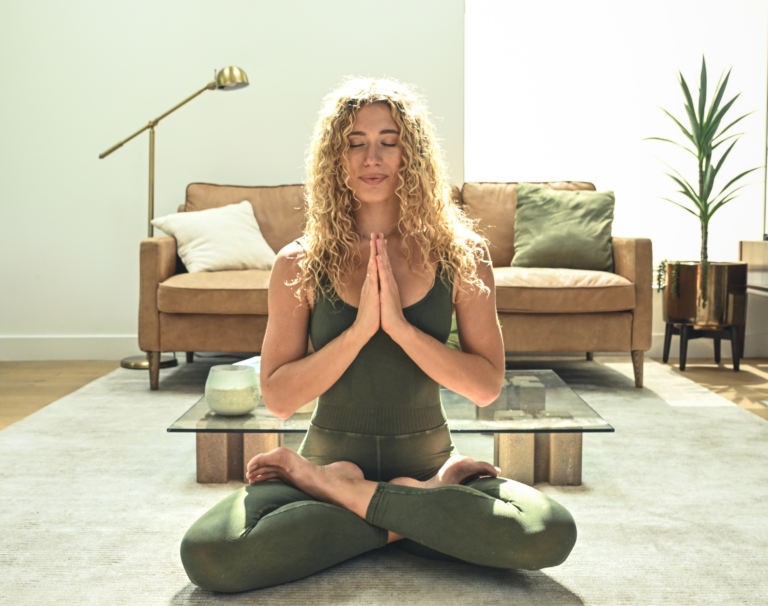A Beginner’s Guide to the Chakras

Chakras (pronounced as chah-kruhs) are energy centers within the body that are believed to correspond to different aspects of our physical, emotional, and spiritual well-being. Beginning to understand the seven chakras and their meanings can help us achieve balance and harmony in our lives, especially when learning to recognize and re-align them when they become blocked.
1. Root Chakra (Muladhara)
The root chakra represents our foundation and is located at the base of the spine. It is associated with stability, grounding, and our basic survival needs. When the root chakra is not balanced, we may feel insecure, anxious, or disconnected from the world around us. To bring the root chakra back into balance, activities such as walking barefoot in nature, practicing yoga poses that focus on the lower body, and using grounding breathing practices like Bahya Khumbaka can be helpful.
2. Sacral Chakra (Svadhisthana)
Located just below the navel, the sacral chakra is associated with our emotions, creativity, and sensuality. When this chakra is not functioning optimally, we may experience a lack of creativity, difficulty forming intimate relationships, or a sense of emotional instability. In order to optimize the sacral chakra, engaging in creative activities, practicing self-care and fluid movement practices, and allowing ourselves to experience pleasure can be helpful.
3. Solar Plexus Chakra (Manipura)
The solar plexus chakra is located in the upper abdomen at the naval center and is associated with our personal power, self-confidence, and sense of identity. When this chakra is blocked, we may struggle with low self-esteem, have difficulty making decisions, feel a lack of motivation, or experience an inability to take aligned actions in our lives. To unblock the solar plexus chakra, repeating positive affirmations, engaging in courageous activities that boost self-confidence, and practicing special breathing exercises like Surya Bhedana can be beneficial.
4. Heart Chakra (Anahata)
Located in the center of the chest, the heart chakra represents love, compassion, and emotional healing. When this chakra is stagnant, we may experience difficulty forming meaningful relationships, feeling disconnected from ourselves or others, and even a sense of resentment or anger. We may also struggle with self-acceptance. To activate the heart chakra, practicing forgiveness, engaging in acts of kindness, and practicing heart-opening yoga poses can bring positive changes to the heart center. This is an important energetic center as it is considered the bridge between the lower chakras (root, sacral, and solar plexus) and the upper chakras (throat, third eye, and crown). Therefore, in order to access the higher expression of consciousness and self-realization, it is imperative to tend to the matters of the heart.
5. Throat Chakra (Vishuddha)
The throat chakra is located in the neck area and is associated with communication, self-expression, and speaking our truth. When this chakra is not balanced, we may have trouble expressing ourselves, fear judgment, or have difficulty setting boundaries and advocating for ourselves. To improve the function of the throat chakra, try journaling to discover your unique voice, engage in honest and open communication, and practice singing or chanting. One effective breathing exercise that stimulates the throat center is called the Bee-Buzzing breath.
6. Third Eye Chakra (Ajna)
Located between the eyebrows, the third eye chakra represents intuition, inner wisdom, and spiritual insight. When this chakra is out of alignment, we may feel disconnected from our intuition, struggle with making decisions, or experience a lack of clarity. To bring the third eye chakra back into alignment, practicing meditation, keeping a dream journal, and engaging in activities that quiet and open the mind, such as yoga nidra and shamanic journeying, can be helpful to re-ignite communication and connection to the invisible realms where clarity and inner-knowing reside.
7. Crown Chakra (Sahasrara)
The crown chakra is located at the top of the head and represents our connection to the divine, higher consciousness, and spiritual enlightenment. When this chakra is blocked, we may feel a lack of purpose or direction in life, experience feelings of isolation, or have difficulty connecting to our spirituality. To unblock the crown chakra, practicing mindfulness, spending time in nature, and engaging in practices like yoga that promote spiritual growth can heighten your connection to the divine and the feeling of unity that connects all beings, all places, and all time together as one.
When beginning to explore the subtle realm of energy, it is important to remember that balancing and aligning the chakras is an endless personal journey that encourages self-awareness and intention. By understanding the seven chakras and their meanings, we open ourselves to the possibility of cultivating well-being and alignment in all aspects of our lives. This transformative aspect of the yoga practice can reveal hidden layers, unlock our potential, and allow us to tap into the vast energy of the universe. Along this path, we can find deep healing, connection to our true selves, and a sense of harmony with the world. Embrace this voyage of self-discovery, dive deep, be patient, stay open and let the wisdom of the chakras guide you towards a balanced, joyful, and spiritually vibrant life.
Great guide! As a beginner, this article helped me understand the basics of chakras clearly and concisely. The descriptions of each chakra and their significance are very enlightening. Thanks for making this complex topic so accessible!
I appreciate this beginner’s guide to the Chakras. It’s insightful and helpful for understanding this fascinating aspect of spiritual and energetic practice.
Fantastic post! Your insights and detailed explanations really helped deepen my understanding of this topic. Looking forward to more content like this.
Thank you so much for creating this blog! The content is incredibly helpful and insightful. Your dedication to sharing valuable information is truly appreciated. Looking forward to reading more of your posts!